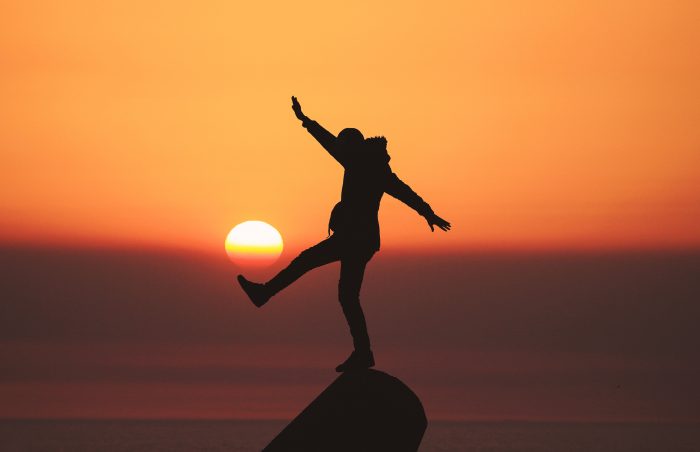In Part I of this article, I discussed the events and research that led me realize how out of balance I was in my relationship to technology. What follows is a list of practices that helped me to restore that balance.
#1 – Do what you can, where you are, with what you have.
This Theodore Roosevelt quote is truly a mantra for overwhelm. When I was working in an office, I hated the way spending 90% of my day in front of a screen time made me feel. I started setting a timer in my web browser to go off every 50 minutes, inspired by this article from DeskTime on productivity. When the alarm went off, I stopped what I was doing and walked away from all devices – no exceptions. I’d walk around the building, get some fresh air, and *gasp* maybe even say hello to another human.
If a few minutes is all you can spare from your screens, consider it tech-triage – sparse, but the first step in a life-saving intervention.
#2 – Get the screens out of your bedroom!
Bedrooms are for sleeping, dreaming, and making love. That’s it – that’s all. So much good happened when I kicked my phone out of bed:
- I slept better – no brainer.
- There was suddenly time for pillow talk and spontaneous intimacy.
- I read more books – reconnecting with the joy of bedtime stories.
- I accidentally became a morning person.
Surprisingly, this wasn’t too hard to pull off. Uncomfortable – yes, initially at least. But this one small adjustment has completely restructured my relationship to technology and mornings. My start-of-day mindset shifted from dread and resentment to pure empowerment, enjoyment, and gratitude – which I never imagined, as a recovering snooze-a-holic, was possible.
Here’s what worked for me:
Step 1: Get a light-up alarm clock like this one from Philips. It simulates the experience of waking up gradually with the sunrise – like humans are supposed to – instead of shocking yourself awake with an obnoxious alarm and beginning your day in a state of terror. I found mine second-hand on a local buy-and-sell website for $20.
Step 2: Charge your phone overnight in a different room – I keep mine in the kitchen because that’s where ideas, creativity and communication flow. At night, put it on silent. I add the most important people in my life to the “exceptions” in my notification settings, so if there’s an emergency in the middle of the night they can still reach me.
Step 3: When the alarm goes off in the morning – before checking your phone – take a few minutes to just lay on the floor, or a yoga mat or a blanket, and just breathe. See what comes. If you’re inspired to move – move. If you crave stillness – be still. This re-trains us to listen to our inner wisdom, whose voice is quiet, gentle and kind.
Step 4: When you’re ready to start your day, get up gradually and try not to rush. If you must reconnect with your devices right away, go for it. But if you have the luxury, see how long you can go about your morning unplugged.
#3 – Carry a pen and get a journal or a day planner
I believe flow is the twin-flame of creativity. They long for each other. And we can’t experience flow if our phones are hijacking our attention every 30 seconds. Plus the physical act of writing expresses the narrative of your inner wisdom. It is like reconnecting with your oldest, dearest friend. The ideas and discussions that come pouring forth are like an entity unto themselves. So when you’re struck with an idea that triggers the impulse to reach for your phone, try writing it down instead and see where it takes you.
#4 – Actually…just…turn off your phone
The first time I did this was not willingly. I was leading camps in remote locations where there was no service. It caused me such anxiety the first week that I would check my pockets obsessively like I had phantom-limb syndrome. But I realized when I got home at night, the world had not fallen apart! Sure – messages, notifications, and reminders still exploded in a digital tantrum, but my life was – amazingly – still intact.
Turning off my phone forced me to build healthy boundaries around my availability. It also forced me to prioritize and examine my interactions. What is urgent? What is important? What is extraneous that I could benefit from letting go of all together – and free up more time to be creative?
We don’t have to retreat into the wilderness to digitally detox. We can slide our phone into airplane mode and just “go dark” for a while – while we’re cooking supper, or walking the dog, having a bath, or commuting home from work. There are so many pockets of time in the day we can use to intentionally unplug until we’re ready to “return”. And in my experience, I feel so refreshed and grateful to return to my notifications after a well deserved vacation from them.
#5 – Do something that nourishes you so deeply you forget about your phone.
For a year, I experimented with dedicating every Wednesday to unplugging and connecting. I called it Peak Day, and it changed my life. It connected me with the people and opportunities I needed to help bring my dreams to life. It created pockets of extra time that I never believed existed. It left me at the end of one year with a limitless roster of skills, activities, interests, hobbies, and friends that I was previously too “busy” to have time for. I hosted more gatherings, learned to dirt-bike, mailed hand-written cards, wandered long and often in nature, bought concert tickets without hesitation – even if the show was on a weekday, and learned to love doing nothing.
In Ayurveda, one of the world’s oldest mind-body health systems, “diet” includes everything we take in, or consume, with our senses. What we see, hear, smell and feel, can nourish or harm us just as much as the food that we eat. Generally, when our sensory impressions are nourishing and in balance – there is wellness. When our sensory impressions are harmful or out of balance – there is disease.
Balancing our relationship to technology is no different than balancing our diet. Some days, we pull off a Pinterest-worthy meal-prep, and some days we stuff our faces with Big Mac’s. Some days, we’re going to unplug and connect with the magic of all existence. And other days, we’re going to binge on technology until our arm goes numb and we’re disgusted with ourselves. And that’s ok – because that’s what real balance looks like.
Balance isn’t walking a tight-rope between self-righteous and unworthy – it’s taken me years of de-conditioning to understand that. Balance is asking ourselves, continually, of everything we consume, “does this nourish me, or not”, and hopefully with practice, making the choice that nourishes us more often.











Read 2 comments and reply